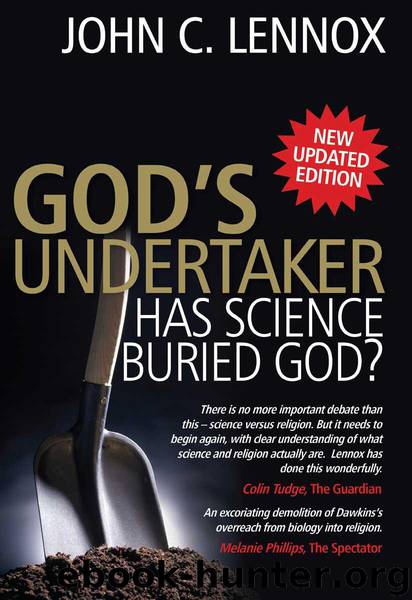God's Undertaker by Lennox John

Author:Lennox, John [Lennox, John]
Language: eng
Format: mobi, epub
Publisher: Lion Hudson
Published: 2011-02-17T16:00:00+00:00
Stasis. Most species exhibit no directional change during their tenure on earth. They appear in the fossil record looking pretty much the same as when they disappear; morphological change is usually limited and directionless.
Sudden appearance. In any local area a species does not arise gradually by the steady transformation of its ancestors; it appears all at once and “fully formed”.’51
Gould and Eldredge’s reading of the fossil record as revealing short periods of rapid change, followed by long periods of stasis, led to their development of the theory of ‘punctuated equilibrium’ to attempt to explain it. The idea is that the long periods of stasis are broken sporadically by sudden large macroevolutionary ‘jumps’. As a spectacular example of such a jump Gould, in his best selling book Wonderful Life,52 describes how all the major phyla (taxonomic ranks) we have today – plus a good many more which have become extinct – appeared very suddenly in the so-called Cambrian Explosion. Of course, the question of what caused such sudden ‘jumps’ is another matter and increases the difficulties of those who wish to argue that microevolutionary processes are an adequate engine for large-scale evolution.
It is interesting and perhaps somewhat ironic that the theory of punctuated equilibrium was embraced by Marxist thinkers long before it had any basis in biology, since it seemed to fit into their dialectical way of thinking. They argued that, when thesis and antithesis clash, the new synthesis occurs rapidly in the form of a jump rather than a long, gradual process. This is another example of how worldviews and ideologies can influence science.
Simon Conway Morris, FRS, of Cambridge University, is more tempered in his approach to the Cambrian Explosion than Gould, but nonetheless thinks that such an explosion took place: ‘Forms transitional between species can be observed today, and can be inferred to have existed in the past. Nevertheless, the net result is very far from a seamless tapestry of form that would allow an investigator to read the Tree of Life simply by finding the intermediates – living and extinct – that in principle connect all species. On the contrary, biologists are much more impressed by the discreteness of organic form, and the general absence of intermediates.’53
The theory of punctuated equilibrium stands in complete contrast to the gradualist approach of the ‘ultra-Darwinians’, such as John Maynard Smith, Richard Dawkins and Daniel Dennett. Indeed, the battle between the two groups has been vitriolic at times. The gradualists, as we have seen, hold that microevolution over time becomes macroevolution. They therefore believe that the very slow accumulation of tiny evolutionary steps over aeons of time can add up to a large innovatory step. Niles Eldredge accuses them of being weak on palaeontology. His argument is that the gradualists are concerned to understand how genetic information comes to be modified over the course of time, and then they simply assert that ‘evolutionary history is the outcome of natural selection working on available genetic variation’.54 In other words, they simply extrapolate from what they observe in the present, backwards through geological time.
Download
This site does not store any files on its server. We only index and link to content provided by other sites. Please contact the content providers to delete copyright contents if any and email us, we'll remove relevant links or contents immediately.
The Lost Art of Listening by Michael P. Nichols(7411)
Why I Am Not A Calvinist by Dr. Peter S. Ruckman(4105)
The Rosicrucians by Christopher McIntosh(3467)
Wicca: a guide for the solitary practitioner by Scott Cunningham(3127)
Signature in the Cell: DNA and the Evidence for Intelligent Design by Stephen C. Meyer(3075)
Real Sex by Lauren F. Winner(2968)
The Holy Spirit by Billy Graham(2894)
To Light a Sacred Flame by Silver RavenWolf(2769)
The End of Faith by Sam Harris(2691)
The Gnostic Gospels by Pagels Elaine(2473)
Waking Up by Sam Harris(2393)
Nine Parts of Desire by Geraldine Brooks(2328)
Jesus by Paul Johnson(2312)
Devil, The by Almond Philip C(2283)
The God delusion by Richard Dawkins(2266)
Heavens on Earth by Michael Shermer(2239)
Kundalini by Gopi Krishna(2138)
Chosen by God by R. C. Sproul(2123)
The Nature of Consciousness by Rupert Spira(2048)
